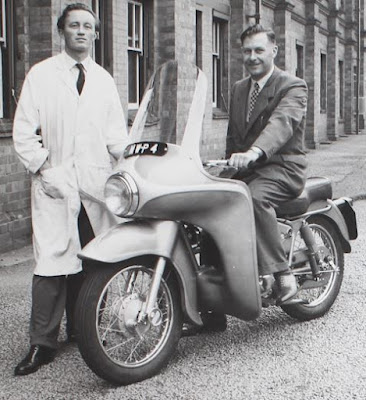 |
| Royal Enfield designer R.E. "Reg" Thomas pictured on 1957 prototype. |
One day in 1969 Royal Enfield design chief Reg Thomas left his offices in Britain to visit Royal Enfield distributors and dealers in the United States and Canada.
It was his first trip to America, an occasion for some culture shock.
Royal Enfield fans in North America probably will recognize themselves as described in Reg Thomas's report on what he learned. It's lively and informative reading, even if you don't own a vintage Royal Enfield.
"The purpose of this visit was to meet distributors, dealers and customers and discuss with them any troubles they had experienced with Royal Enfield motorcycles," he wrote in his typewritten report, now in the archives of the Royal Enfield Owners Club UK.
Of course, he fully expected to get an earful.
By this time, Royal Enfield in UK had dropped most of its lines of motorcycles. Only the newly designed Interceptor Series II remained in production, in the underground factory in Upper Westwood.
Thomas himself did not know that the Royal Enfield was near the end of the line in Britain. The factory would close and the final 750cc Interceptors would be "1970 1/2" models.
 |
| Reg Thomas discussed the end of Royal Enfield UK in TV documentary. |
In Fall 1969 his hopes for the future were still high. He approached his task as though real development and improvement would be possible, displaying all his optimism, tact and humor in his report on conditions in America.
He arrived in Boston Sept. 8, 1969 to meet with Sam Avellino and his two sons, who were critical of the Interceptor's performance. A particularly troublesome motorcycle reported to Britain had been re-sold to an owner 500 miles from Boston, too far away for Thomas to check it out. That must have been a relief.
There was more joy at Shillingford and Sons in Bristol, Pa., where dealers invited to meet Thomas "were all very keen and thought the Series II machine a big improvement over the 1968 model." They suggested more support for competitive events.
Moving on to Shores Motorcycles, in Michigan, Thomas encountered dealer Marlin Berg of Inter Continental Sales, who "was extremely critical of the 1968 model and gave me a very uncomfortable two hours as he read out a list of faults which must have included every kind of trouble we have ever experienced. Marlin sold 50 Series I models in 1968 and only five Series II models in 1969... This dealer had so many troubles with 1968 machines that he was trying not to sell 1969 models for fear of having more troubles next year."
The next day, Thomas visited Marlin's Detroit shop, with its barred windows and barbed wire strung at the rear.
"During my visit a customer known as 'Troop' brought his Series II model in and complained of a noise in the rear hub. Troop was a coloured gentleman wearing a chrome plate German stormtroopers helmet," Thomas relates.
Thomas was prepared to take Americans as they came.
"In spite of Marlin Berg's animosity when first we met, we parted good friends. He is a good salesman and I would like to see him trying to sell Enfields again," Thomas recorded.
 |
| One paragraph in Reg Thomas's typewritten 1969 report. |
It was on to Los Angeles to visit Floyd Clymer Motorcycles, meet renowned tuner Shell Thuet at Shells Motors, and spend an evening at the home of Bonneville Salt Flats racer Don Sliger. He would watch racing at Ascot, where Enfields held track records from 1963 and 1964.
"Winning a few races at this track with a machine using the latest Interceptor engine would be better publicity than six months advertising in the American motorcycle journals," he decided.
The report concludes with a long list of problems, suggestions and observations gathered from the contacts Thomas made in the U.S. and Canada.
A sampling:
"Can we make a larger engine; say 800!" (Thomas probably used an exclamation point here because he knew that Royal Enfield already had an 800cc Interceptor in development.)
"Ignition key fouls riders leg when kick starting."
"Engines 'hunt' when idling in very hot weather."
"Barry Tilman insists that cradle frame is necessary; not for rigidity but because other machines have cradle frames."
"Douglas Tatro suggests that we make all running clearances in the engine too tight; takes too long before an Enfield is fully run in."
"Lucas batteries are useless."
"Dealers should be supplied with assembly instruction leaflet."
"A drain plug in the primary chain case would be appreciated."
"A reserve fuel tap is necessary."
"A tank badge would give the machines more 'class'."
And nearly every dealer stressed this: "quarter-mile speeds most important."
It was a useful introduction to the American market, but one Thomas and Royal Enfield UK would barely have a chance to exercise.
Dave hits a home run! What a fabulous gander into RE machinations from over 1/2 century ago. Perhaps undercapitalized yet hope remained. A true shame that the AMA dawdled making 750 OHV the racing spec. Win on Sunday, sell on Monday seems even more valid looking back. Phil/NJ. PS. Was @ Middletown last week for a very impressive RE showing!
ReplyDelete